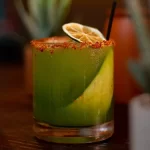In the realm of spirits, where flavors dance on the palate and stories are told through each sip, two luminaries emerge, beckoning us to unravel their mysteries. Mezcal and tequila, cherished spirits from the heartlands of Mexico, ignite the senses and captivate the soul. Like a vibrant symphony, they harmonize tradition, craftsmanship, and taste, while unveiling their distinctive charms. Let us embark on a journey of discovery, where we delve into the essence of mezcal and tequila, understanding the differences that set them apart.
1. Introduction: The Enigmatic Spirits
In the heartland of Mexico, amidst the rugged terrains and ancient traditions, Mezcal and Tequila reign as spirits steeped in allure and mystique. Both born from the majestic agave plant, these libations hold stories woven with passion, history, and craftsmanship. Mezcal and Tequila, entwined in the tapestry of Mexican culture, invite us to explore the nuances of their creation, flavor profiles, and the traditions they embody.
2. Origins and Heritage
Mezcal, the elder statesman, traces its lineage to pre-Hispanic times, where it was revered as a sacred elixir. From the arid lands of Oaxaca, Mezcal embodies the wisdom of ancient civilizations, preserving their traditions through the ages. Tequila, on the other hand, hails from the state of Jalisco, its birthplace nestled among blue agave fields. Developed from the same plant, these two spirits diverge in their production techniques, creating a world of difference in taste and character.
3. Production Process: A Tale of Two Techniques
To craft mezcal, the hearts of the agave plant, known as piñas, are slow-roasted in earthen pits, infusing them with smoky flavors. Afterward, they are crushed, fermented, and distilled in small batches, emphasizing artisanal methods. Tequila, on the contrary, follows a more industrial process. The piñas are steamed, resulting in a cleaner, more predictable flavor profile. While mezcal embraces tradition and the art of handcrafted production, tequila boasts efficiency and consistency.
4. Agave Varieties: The Key Players
Within the vast agave family, distinct varieties take center stage in the realms of mezcal and tequila. Mezcal thrives on the diversity of agave types, encompassing Espadín, Tobalá, and Arroqueño, each lending its own character to the final product. Tequila, on the other hand, primarily relies on the blue agave, also known as Agave tequilana Weber, the noble agave that embodies the essence of this revered spirit.
5. Terroir: A Sense of Place
The land from which agave takes root profoundly influences the spirits it yields. Mezcal exemplifies this concept with its concept of terroir, where the soil, altitude, and climate impart distinct flavors and complexities. From the mist-laden mountains to the sun-drenched valleys, each mezcal bears the signature of its birthplace. Tequila, although often associated with specific regions, is more focused on consistency, drawing its flavors from the blue agave fields of Jalisco and surrounding areas.
6. Flavor Profiles: The Artistry Unleashed
Mezcal unveils a kaleidoscope of flavors, dancing on the palate with smoky notes, earthy undertones, and a symphony of botanical essences. Its robust character and depth enthrall the senses, inviting contemplation and appreciation. Tequila, on the other hand, captivates with a vibrant profile that showcases the sweet, herbaceous, and citrusy facets of the blue agave. Its versatility shines through, whether enjoyed neat, in cocktails, or sipped alongside traditional Mexican fare.
7. Drinking Rituals: The Celebration of Moments
The consumption of mezcal and tequila transcends mere libation; it is an ode to celebration and communion. Mezcal embraces tradition, often savored neat or enjoyed alongside orange slices dusted with sal de gusano, a savory blend of spices and ground worms. Tequila, a global icon, thrives in margaritas, palomas, and tequila sunrises, complementing joyous occasions and moments of revelry.
8. Global Popularity: A Rising Tide
In recent years, the allure of mezcal and tequila has transcended borders, captivating the global stage. Mezcal, with its artisanal appeal and flavors steeped in history, has found favor among connoisseurs seeking authenticity and complexity. Tequila, a mainstay in bars and households worldwide, continues to evolve, with premium expressions garnering recognition and acclaim. Together, they symbolize the essence of Mexico, bridging cultures through their intoxicating allure.
9. Pairing Possibilities: A Gastronomic Adventure
Mezcal and tequila, with their diverse flavor profiles, invite culinary exploration and gastronomic adventures. Mezcal’s smoky notes find harmony alongside grilled meats, spicy dishes, and aged cheeses, adding a layer of complexity to the dining experience. Tequila, with its versatile and vibrant character, elevates seafood, ceviche, and tropical fruits, creating harmonious symphonies of taste on the palate.
10. Mezcal vs Tequila: A Summary
In the realm of mezcal and tequila, the spirits of Mexico entwine with tradition, craftsmanship, and cultural heritage. Mezcal, the elder sibling, captivates with its artisanal production, smoky allure, and diverse flavor profiles. Tequila, the global icon, embodies the vibrancy of the blue agave, crafting a spectrum of tastes that inspire joyous celebrations. Both spirits have carved their place in the world, inviting us to indulge in their magic and unravel the mysteries that lie within.
11. Conclusion
As we bid farewell to the mesmerizing world of mezcal and tequila, we carry with us the knowledge of their origins, production processes, and the distinct flavors that define them. These spirits, born from the same agave plant, embark on unique journeys, offering us glimpses into the rich tapestry of Mexican culture. Whether sipping mezcal’s smoky poetry or reveling in tequila’s vibrant symphony, let us toast to the wonders that these spirits bring and the stories they inspire.
FAQs: Unraveling Curiosities
- Q: What is the main difference between mezcal and tequila?
- A: The main difference lies in their production processes. Mezcal is traditionally made through artisanal methods, while tequila follows a more industrial process.
- Q: Does mezcal taste smoky?
- A: Yes, mezcal often exhibits smoky flavors due to the slow-roasting of agave piñas in earthen pits during its production.
- Q: Can tequila be made from different agave varieties?
- A: Tequila is primarily made from the blue agave variety, known as Agave tequilana Weber, although other agave species can be used in certain tequila expressions.
- Q: How should I drink mezcal?
- A: Mezcal can be enjoyed neat or alongside orange slices sprinkled with sal de gusano, a traditional seasoning.
- Q: What are some popular tequila cocktails?
- A: Margaritas, palomas, and tequila sunrises are among the popular cocktails made with tequila.
In the dance of mezcal and tequila, we uncover the magic that resides within each sip. From the ancient traditions of mezcal to the vibrant legacy of tequila, these spirits encapsulate the essence of Mexico’s soul. Let us raise our glasses, celebrate their differences, and embark on a journey of discovery through flavors, stories, and the artistry of these remarkable libations.



